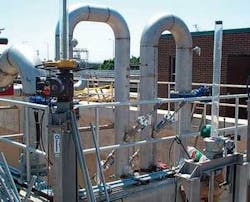Utilities Selecting Ultrasonic Flow Measurement for Digester Gas
The measurement of gas coming from a digester is becoming increasingly important as more wastewater treatment plants use the gas as a fuel, or sell it to someone else as a fuel. Also, digester gas typically cannot be vented to the atmosphere and environmental regulations require accurate reporting of the amount of gas vented or large fines can result.
As plants evaluate options for their flow measurement, they often find that ultrasonic meters can best fit their needs.
The Central Valley Water Reclamation facility in Salt Lake City, Utah, represents an example of how measurement of digester gas has increased in the industry during recent years. The facility’s digester gas is used to fuel gas turbines at its power plant, helping generate electricity. At certain times of the year when electricity demands are low, the digester gas can handle 100% of Central Valley Water’s fuel needs, making the plant self-sufficient.
Accurate measurement of the methane flow determines if natural gas purchased from a city gas supply needs to be added to the flow to ensure sufficient fuel for running the turbines. Plant engineers chose to measure digester gas flow with ultrasonic technology because it requires minimal maintenance and can operate for years without having any shift in flow measurement accuracy.
Original meters installed at Central Valley Water in 2001 have been operating consistently without failure since commissioning and the facility recently purchased additional ultrasonic meters to monitor more lines.
Ultrasonic flowmeters employ transit time technology used successfully in many liquid, gas and steam applications. Typical installations include one pair of transducers per path. Each transducer consists of a piezoelectric crystal encapsulated in a metal that generates and detects ultrasonic signals. The upstream and downstream transducers transmit and receive signals from each other.
If there is no flow in the line, the transit times of the acoustic signals are the same going in each direction. When the gas starts flowing, it slows down the signal transmitted against the flow from the downstream transducer and accelerates the signal traveling with the flow from the upstream transducer. The difference of those two signals is directly proportional to the velocity of the gas. Using the path length (P) and axial dimension (L), flowing velocity can be calculated directly. Knowing the size of the pipe allows the meter to calculate the volumetric flow by multiplying the velocity by the cross section area of the pipe (Q = V * A).
Ultrasonic flow measurement works effectively in dirty environments because it is not affected by slight build-up or contamination of the sensors. The main measurement of the meter is time-based and the differential nature of the calculations eliminates the effects of changing gas composition or slight changes from build-up on the transducer. Ultrasonic flowmeters also are very linear, allowing them to operate accurately over a very large range of flowing velocities. The models used at Central Valley Water measure as low as 1 ft/sec up 150 ft/sec.
Ultrasonic meters do not require programmable logic controllers (PLCs) or purge systems to operate. Compared to other technologies their acquisition cost may be a little more expensive, but without the need for supporting equipment like PLCs and purge systems, ultrasonic meters can be very cost effective. Many customers report that they have never needed to service their ultrasonic meter, saving them time and money.
Gas Flow Study
The Orange County Sanitation District conducted a long-term study of digester gas applications that evaluated three technologies, including ultrasonic flowmeter technology, on 42-inch foul air ducts. Performance was compared against a third party air balance and tests were conducted over 11 weeks. On the eighth week, the ultrasonic meter’s transducers were removed and inspected. A slight build-up of dirt on the transducers was cleaned prior to reinstalling the transducers. The customer brought the meter back online and when tested again, the meter experienced virtually no change in flow. The meter readings, on average, varied by 0.7% from the standard measurement device during the test.
About the Author
Chris Frail is a flow product manager at GE Sensing. He has more than nine years of experience with design, production, calibration, and application of both clamp-on and wetted ultrasonic flowmeters. He holds a BS in Mechanical Engineer from Boston University.



